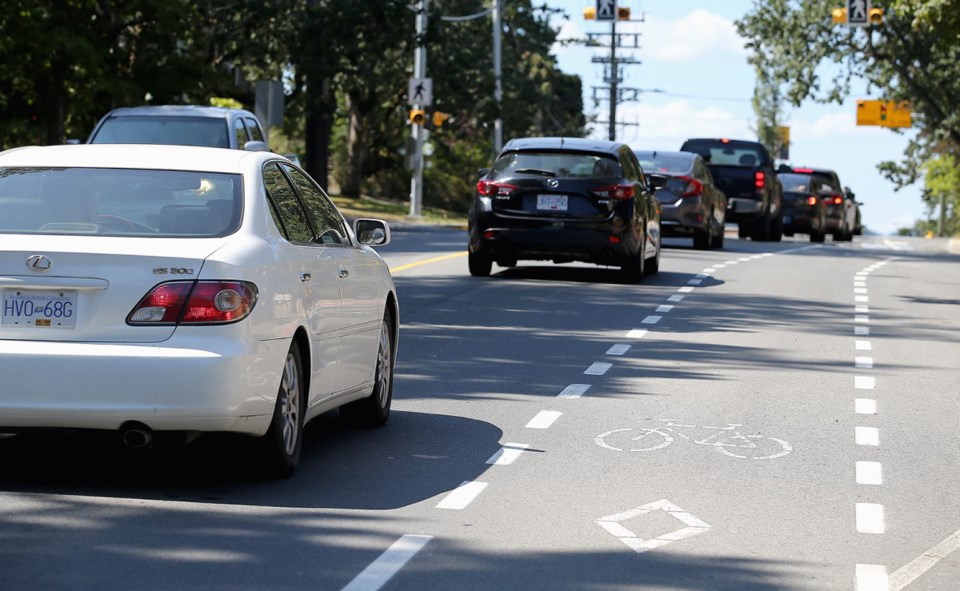A West Shore RCMP officer has been cleared of wrongdoing in a collision that left a cyclist with serious injuries on a stretch of road where cycling advocates say a bike lane should be designated.
The Independent Investigations Office of B.C., a civilian-led agency that looks into police-related cases linked to death or serious injury, investigated the incident that took place on Sept. 12, 2019, on Admirals Road near Songhees First Nation to determine whether the officer committed an offence by failing to signal his turn or driving without due care.
Chief civilian director Ronald MacDonald found no reason to believe the officer was negligent, despite “persuasive evidence” he didn’t use his turn signal, because he would not have expected the cyclist, who was riding on the road’s paved shoulder, to pass his vehicle on the right.
Passing on the right is prohibited in B.C. for vehicles and bikes, except when cyclists are using designated bike lanes, a senior Transportation Ministry manager told the IIO.
The shoulder on the part of Admirals Road where the collision occurred is not considered a bike lane, but it connects seamlessly to one, cycling advocates say.
The officer was heading northbound on Admirals Road around 4:30 p.m. in heavy rain and making a right turn onto Seenupin Road when he struck the female cyclist. She was thrown over the front of the car and landed on the road, according to a witness driving directly behind the officer.
The witness told the IIO he was quite certain the officer did not use his turn signal, because police are “always on us for not doing it, that’s why it stuck with me.”
The cyclist was riding her regular route home from work, also heading northbound on Admirals Road, according to the report.
Admirals Road has a designated bike lane on either side until the boundary between Esquimalt and Songhees First Nation. At that point the painted bike lane symbols stop, and it’s considered a narrow, paved shoulder, but not a designated bike lane. About 150 metres down the road, a sign indicates that cyclists are allowed to ride on the sidewalk.
Because the cyclist was not using a designated bike lane, MacDonald found she passed the officer’s vehicle unlawfully and his duty to check for bikes passing on the right was “somewhat reduced.”
MacDonald’s report also noted the woman was wearing dark clothing and did not have a front light on her bike. “Any reasonable shoulder check could quite easily miss a bicycle that was difficult to see and unexpectedly passing in an unlawful manner,” MacDonald wrote.
The collision was not the first between a motorist and a cyclist on the particular stretch of Admirals Road. A cyclist was hit by a left-turning vehicle a few years ago in similar circumstances, during backed-up, rush hour traffic, said Corey Burger, policy infrastructure chair of the Greater Victoria Cycling Coalition.
The case went to court, and the cyclist was found partially liable because he was not using a designated bike lane, Burger said.
In 2017, the cycling coalition asked the ministry to designate a bike lane on that part of Admirals, as there is no difference from a user’s perspective between the shoulder and the bike lane to the south, Burger said.
“The bare minimum of what the ministry needs to do is go out there on these roadways, like this one and all the other ones, and designate them as bike lanes. They could do that tomorrow. You know, it will take a couple of cans of paint, they own the stencils, and then the signs can go up,” he said.
Burger also took issue with the report’s focus on details about the cyclist’s dark clothing and lack of light, because the crash happened around 4:30 p.m. in mid-September. He noted the legal requirement for having a bike light according to the Motor Vehicle Act is half an hour after sunset, which would have been around 7:30 p.m. on the date of the collision.



